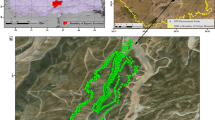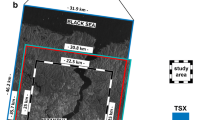Abstract
The bistatic spaceborne/stationary InSAR configuration could be applied to generate digital elevation model (DEM). However, two factors limit the DEM precision improvement. On the one hand, due to the effects of the illuminator’s sidelobe and the high objects’ shadow, the pixels in the corresponding area might be polluted by the noise. On the other hand, owing to the presence of deviation (between the real value and the nominal value of the master/slave antenna positions), after utilizing the nominal value to compensate for the reference phase, the residual reference phase would remain. In order to solve the problems, we proposed a new bistatic DEM generation algorithm. Firstly, we applied the coherence-phase joint analysis method to select high-coherence points. Secondly, we deduced the transforming relationship from the deviation to the residual reference phase, and then compensated for the residual reference phase. In the experiment, the YaoGan-3 (an L-band spaceborne SAR) was selected as the transmitter and the two stationary receivers were mounted on the top of a tall building. The algorithm recommended in this paper was applied to process the measured bistatic data. The analysis of the results demonstrated that the elevation error of the generated DEM for some targets had been limited to the level of 1–2 m.
Similar content being viewed by others
References
Duque S, Lopez-Dekker P, Mallorqui J. Single-pass bistatic SAR interferometry using fixed-receiver configurations: theory and experimental validation. IEEE Trans Geosci Remote sens, 2010, 37: 231–234
Sanz-Marcos J, Lopez-Dekker P, Mallorqui J, et al. SABRINA: a SAR bistatic receiver for interferometric applications. IEEE Geosci Remote Sens Lett, 2007 4: 307–311
Zhu M, Hu C, Zeng T, et al. Fixed-receiver bistatic interferometric algorithms analysis and implementation. In: Proceedings of IEEE Radar Conference (RADAR), Ottawa, 2013. 1–4
Zhu M, Hu C, Zeng T, et al. Experimental results and analysis for Bistatic SAR interferometry using stationary receiver. In: Proceedings of IET International Radar Conference, Xi’an, 2013. 1–4
Duque S, Lopez-Dekker P, Merlano J, et al. Bistatic SAR along track interferometry with multiple fixed receivers. In: Proceedings of Geoscience and Remote Sensing Symposium (IGARSS), Honolulu, 2010. 4099–4102
Duque S, Lopez-Dekker P, Merlano J, et al. Bistatic SAR tomography: processing and experimental results. In: Proceedings of Geoscience and Remote Sensing Symposium (IGARSS), Honolulu, 2010. 154–157
Lopez-Dekker P, Mallorqui J, Serra-Morales P, et al. Phase synchronization and Doppler centroid estimation in fixed receiver bistatic SAR systems. IEEE Trans Geosci Remote sens, 2008, 46: 3459–3471
Sanz-Marcos J, Prats P, Mallorqui J, et al. A subaperture range-Doppler processor for bistatic-fixed-receiver SAR. In: Proceedings of EUSAR, Dresden, 2006
Sanz-Marcos J, Mallorqui J, Aguasca A, et al. First ENVISAT and ERS-2 parasitic bistatic fixed receiver SAR images processed with the subaperture range-Doppler algorithm. In: Proceedings of International Conference on Geoscience and Remote Sensing Symposium, denver, 2006. 1840–1843
Qiu X, Hu D, Ding C. An improved NLCS algorithm with capability analysis for one-stationary BiSAR. IEEE Trans Geosci Remote sens, 2008, 46: 3179–3186
Wang R, Deng Y, Zhang Z, et al. Double-channel bistatic SAR system with spaceborne illuminator for 2-D and 3-D SAR remote sensing. IEEE Trans Geosci Remote sens, 2013, 51: 4496–4507
Zhang Q, Chang W. Performance analysis of bistatic interferometer based on spaceborne SAR. Prog Electromagn Res, 2013, 142: 721–742
Zhang Q, Chang W, Yan F. Bistatic Interferometer Based on Spaceborne SAR. In: Proceedings of IET International Radar Conference, Xi’an, 2013. 1–5
Zeng T, Hu C, Wu L, et al. Extended NLCS algorithm of BiSAR systems with a squinted transmitter and a fixed receiver: theory and experimental confirmation. IEEE Trans Geosci Remote sens, 2013, 51: 5013–5030
Zeng T, Wang R, Li F, et al. A modified nonlinear chirp scaling algorithm for spaceborne/stationary bistatic SAR based on serial reversion. IEEE Trans Geosci Remote sens, 2013, 51: 3108–3118
Wang R, Li F, Zeng T. Bistatic SAR experiment, processing and results in spaceborne/stationary configuration. In: Proceedings of IEEE CIE International Conference on Radar, Chengdu, 2011. 393–397
Zeng D, Wang R, Zeng T, et al. An improved CSA for one-stationary BiSAR squint mode. In: Proceedings of IEEE International Geoscience and Remote Sensing Symposium, Honolulu, 2010. 1577–1580
He F, Chen Q, Dong Z, et al. Modeling and high-precision processing of the azimuth shift variation for spaceborne HRWS SAR. Sci China Inf Sci, 2013, 56: 102304
Fan B, Ding Z, Gao W, et al. An improved motion compensation method for high resolution UAV SAR imaging. Sci China Inf Sci, 2014, 57: 122301
Ferretti A, Prati C, Rocca F. Nonlinear subsidence rate estimation using permanent scatterers in differential SAR interferometry. IEEE Trans Geosci Remote sens, 2000, 38: 2202–2212
Ferretti A, Prati C, Rocca F. Permanent scatterers in SAR interferometry. IEEE Trans Geosci Remote sens, 2001, 39: 8–20
Just D, Bamler R. Phase statistics of interferograms with applications to synthetic aperture radar. Appl Opt, 1994, 33: 4361–4368
Author information
Authors and Affiliations
Corresponding author
Rights and permissions
About this article
Cite this article
Zeng, T., Zhu, M., Hu, C. et al. DEM generation using bistatic interferometry: High-coherence pixel selection and residual reference phase compensation. Sci. China Inf. Sci. 58, 1–14 (2015). https://doi.org/10.1007/s11432-015-5333-7
Received:
Accepted:
Published:
Issue Date:
DOI: https://doi.org/10.1007/s11432-015-5333-7




